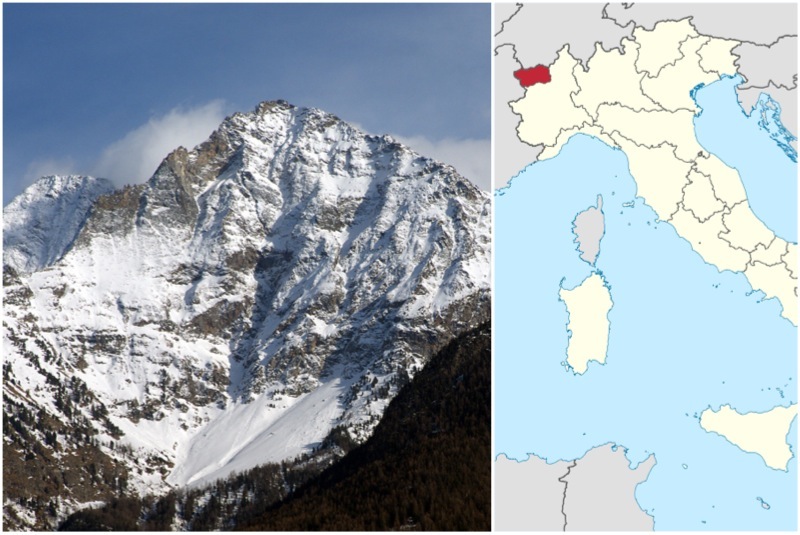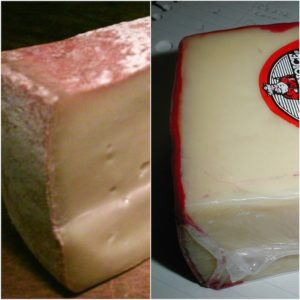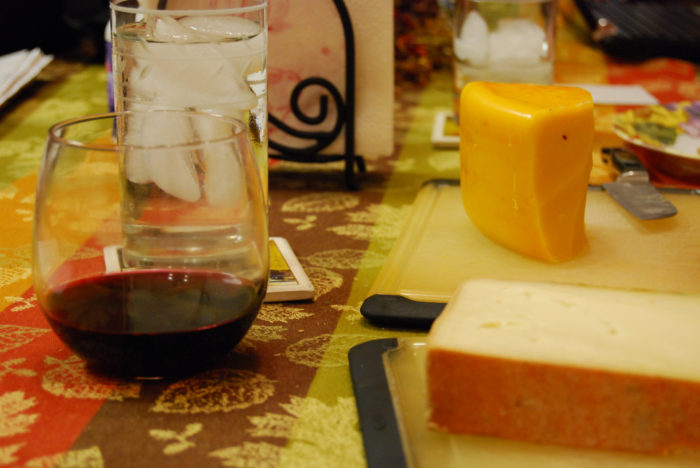Fontina is an Italian raw milk cheese from the Val d'Aosta region of Italy. The Aosta Valley is a semi-autonomous, French-speaking region in the northwest of Italy, located near the Alps, by the French and Swiss borders.

(Left side) Photo by Fabrizio Binello
Italian Fontina is made from unpasteurized cow’s milk, is straw-colored with varying brown or tan-colored rind.
Italian Fontina has protected designation of origin (PDO) status, which is enforced by the EU. This is basically a type of trademark, which applies to a specific region where a food is made. The idea behind this legislation is that it promotes and protects names of quality. That is to say, the reputation of the Fontina that everyone thinks of as being produced in the Aosta Valley for hundreds of years should not be damaged by the sale of similar, inferior cheeses made in other regions or countries. The law does this by ensuring that products meet rigorously high, quality standards. So, even though Fontina is produced in Sweden and Denmark, it is considered a) a different product, and b) inauthentic.
What’s the difference between Swedish and Italian Fontina?
Rind
The most important difference between Italian and Scandinavian Fontina, is the rind. In Italy, Fontina has a natural rind, due to the aging process. It’s usually an orange-brown color.

(Right side) Danish Fontina by Sean
Flavor and Texture
Italian Fontina vary from semi-firm to hard depending on the length of the aging process. However, Swedish and Danish Fontina are typically aged for far less time; and,therefore, are generally milder and considered semi-soft.
Price
An Italian fontina that have been stamped with the mark of the consortium--indicating that the cheese is authentic Valdastoan Fontina--will have a high quality, although it will likely cost more than other varieties of the cheese made in other parts of Italy or other countries.
How to buy?
Fontina is available all year round, so there isn’t a better time to buy it than right now. According to Foodista, when you’re buying Fontina, you’re looking for a cheese with even texture and color; and, don’t be afraid of older Italian Fontina’s, which can have a much stronger smell.

How to eat Fontina?
Young fontina is best for fondue--by young, of course, I mean fontinas that have been Italian Fontina is actually a hard cheese, and does not fare very well. Because Swedish Fondue is not as hard as it’s Italian counterpart, it’s great for fondue.
Fontina is the primary ingredient in Italian fonduta and is a wonderful table or dessert cheese. Some other
| Food | Wine |
|---|---|
| veal, prosciutto, Genoa salami, crusty bread, peaches, melons, figs, nectarines, egg dishes, crepes, and fondue | Red: Beaujolais, Pinot Noir, Nebbiolo, Vouvray, Chianti
White: Riesling, |
Many people also add fontina to dough for cheese breads, or melted in panninis or sandwiches. You can also try this simple recipe for prosciutto Fontina hand pies.
Wrapping up
So, what did we learn? Let’s quickly review:
- There are regional varieties of Fontina, but the one true Fontina comes from Aosta Valley in northern Italy.
- Italian Fontina, depending on how old it is, is more of a table cheese; as opposed to it’s scandinavian cousins, which are much softer and are great for melting and fondue.
- The most obvious difference between Italian and Swedish or Danish varieties is that the Italian one has a natural rind as opposed to red wax.
I know someone is going to ask this, so let me just put it out there now. No, you don't eat the red wax rind; however, you should definitely be eating the natural rind on Italian Fontina. Go pick some up and make a toasted sandwich, you won't regret it.
Let me know in the comments how you enjoy Fontina.